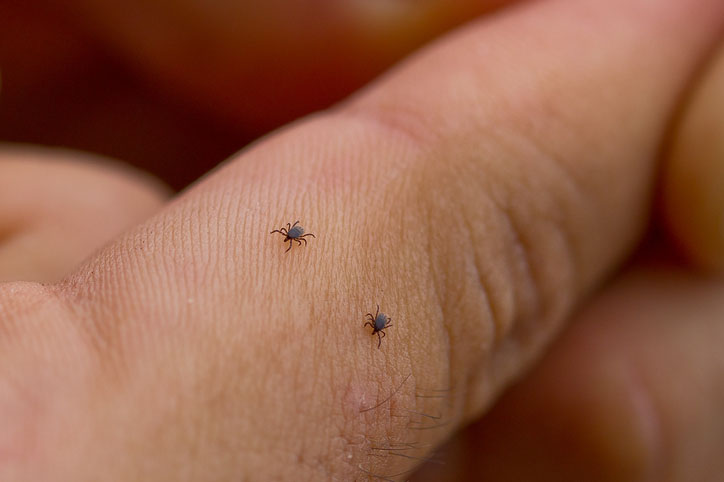Rocky Mountain Spotted Fever
(Rickettsia rickettsii infection)
- Rickettsial Diseases
- Ehrlichiosis and Related Infections
- Rocky Mountain Spotted Fever
- Murine Typhus
- Salmon Poisoning Disease and Elokomin Fluke Fever
Etiology:
Rocky Mountain spotted fever (RMSF) is a disease of people and dogs caused by Rickettsia rickettsii. R rickettsii and closely related members of the spotted fever group of rickettsiae are considered endemic throughout much of North, South, and Central America. These pathogens are transmitted primarily through the bites of infected ticks. The ability of genetically similar rickettsial organisms, such as R parkeri, to cause clinically similar disease in dogs is unknown. Because of their susceptibility to R rickettsii and relatively higher rates of tick exposure, dogs may serve as excellent sentinels of risk for R rickettsii infection in people. Clusters of disease are frequently reported in defined geographic areas, and temporally associated infections may be seen in both dogs and their owners.
Epidemiology:
In the USA, Dermacentor variabilis (the American dog tick) and D andersoni (the Rocky Mountain wood tick) are considered the primary vectors for R rickettsii. In South America, several Amblyomma spp of ticks have been implicated in transmission. The organism has also been isolated from Rhipicephalus sanguineus ticks (the brown dog tick), which appear to be the primary vector in some focal areas of Arizona, particularly on American Indian tribal lands, and may also play an as-yet unappreciated role in outbreaks elsewhere in the USA. R sanguineus ticks are also associated with transmission of R rickettsii in Central America and with large city-based outbreaks in Mexico. The pathogen is acquired by larval and nymph stages of ticks while feeding on infected vertebrate hosts and is also passed from female ticks to progeny through transovarial transmission. An estimated <1% of Dermacentor spp ticks carry R rickettsii, even in areas considered highly endemic. In highly enzootic regions of Arizona where R rickettsii is transmitted by the brown dog tick, as many as 5% of ticks may be infected.
Seroprevalence in dogs from endemic areas ranges from 4.3%–77%, but these values do not accurately reflect infection rates because of the detection of cross-reacting antibodies to other genetically similar rickettsiae. RMSF transmission through blood transfusion has been documented in a single human case and should be considered when selecting canine blood donors. Direct transmission from dogs to people has not been reported, although human infection may occur after contact of abraded skin or conjunctiva with tick hemolymph or excreta during removal of engorged ticks from pets.
Clinical Findings:
Dogs are highly susceptible to clinical infection with R rickettsii; in contrast, it is rarely diagnosed in cats. Early signs in dogs may include fever (up to 105°F [40.5°C]), anorexia, lymphadenopathy, polyarthritis, coughing or dyspnea, abdominal pain, vomiting and diarrhea, and edema of the face or extremities. Petechial hemorrhages of the conjunctiva and oral mucosa may be seen in severe cases. Focal retinal hemorrhage may be seen during the early course of disease. Neurologic manifestations such as altered mental states, vestibular dysfunction, and paraspinal hyperesthesia may occur.
Thrombocytopenia is common. Leukopenia develops during the early stages of infection and, in untreated cases, is followed by progressive leukocytosis. Serum biochemical abnormalities may include hypoproteinemia, hypoalbuminemia, azotemia, hyponatremia, hypocalcemia, and increased liver enzyme activities. Case fatality rates of ~1%–10% are expected.
Lesions:
Vascular endothelial damage is due to direct cytopathic effects of the rickettsiae. Severity of the necrotizing vasculitis can be directly correlated to the infective dose. Vascular endothelial damage and thrombocytopenia contribute to development of petechiae and ecchymoses. Necrosis of the extremities (acryl gangrene) or disseminated intravascular coagulation can develop in severely affected dogs.
Diagnosis:
Currently, there are no in-house diagnostic tests available for diagnosis of acute RMSF in dogs. Indirect fluorescent antibody titer (IFA) is preferred for serologic testing. However, because of the high incidence of cross-reacting antibodies to a variety of nonpathogenic spotted fever group rickettsiae, as well as longterm persistence of antibodies after acute RMSF infection, demonstration of a 4-fold rise in titer should be documented in conjunction with a compatible clinical syndrome. Differential diagnoses include other causes of fever of unknown origin. The therapeutic response is usually dramatic, as it is in other canine rickettsial diseases. Animals with neurologic dysfunction may have residual deficits. Immunity appears to be lifelong after natural infection; therefore, recurrent episodes should not be attributed to RMSF.
Treatment:
Antibiotic treatment should be administered based on clinical suspicion without waiting for results of serologic tests, because delayed administration of antibiotics may result in higher rates of severe or fatal outcome. Doxycycline is the treatment of choice, regardless of age of the dog, and should be administered at a dosage of 5–10 mg/kg/day, PO or IV, for 10–21 days. Tetracycline at 22 mg/kg, PO, tid for 2 wk is also effective. Chloramphenicol has been used to treat RMSF in the past, but its use is associated with higher rates of fatal outcome in human patients, and it is not recommended. Other broad-spectrum antibiotics are ineffective against R rickettsii infection, and there is some evidence in human cases that use of fluoroquinolones may actually worsen infection. Early seronegative tests should not be considered a reason to stop therapy, because antibodies may take ≥1 wk to develop in acute cases. Supportive care for dehydration and hemorrhagic diathesis may be necessary. Because of alterations in vascular integrity, conservative rates of fluid administration are advised. Precautions should be taken for the safe removal and control of ticks. In settings in which R rickettsii transmission from R sanquineus is suspected, medications and products with proven efficacy against this tick species are important to use. Because R sanguineus infestations can be problematic in kennels and around homes, and longterm tick control is needed for outbreak control, use of effective long-acting tick collars on all susceptible dogs might be considered; collars containing propoxur, amitraz, or flumethrin have proven activity against R sanguineus.
Zoonotic Risk:
R rickettsii is considered a zoonotic pathogen. The potential for household clustering and large urban outbreaks, particularly in areas with transmission by brown dog ticks, makes RMSF a disease of significant public health concern. Although clinical disease occurs in both animals and people, the involvement of a required intermediate tick vector for transmission means dogs and other infected animals do not pose a direct transmission risk in normal circumstances. Infection in dogs indicates a heightened risk of human infections related to tick exposure in a given area, and serologic studies of dogs in emerging areas may help predict human risk of infection. Particularly in areas where transmission occurs via R sanguineus, close cooperation between veterinary, medical, and public health officials is important to achieve control.
- Rickettsial Diseases
- Ehrlichiosis and Related Infections
- Rocky Mountain Spotted Fever
- Murine Typhus
- Salmon Poisoning Disease and Elokomin Fluke Fever





